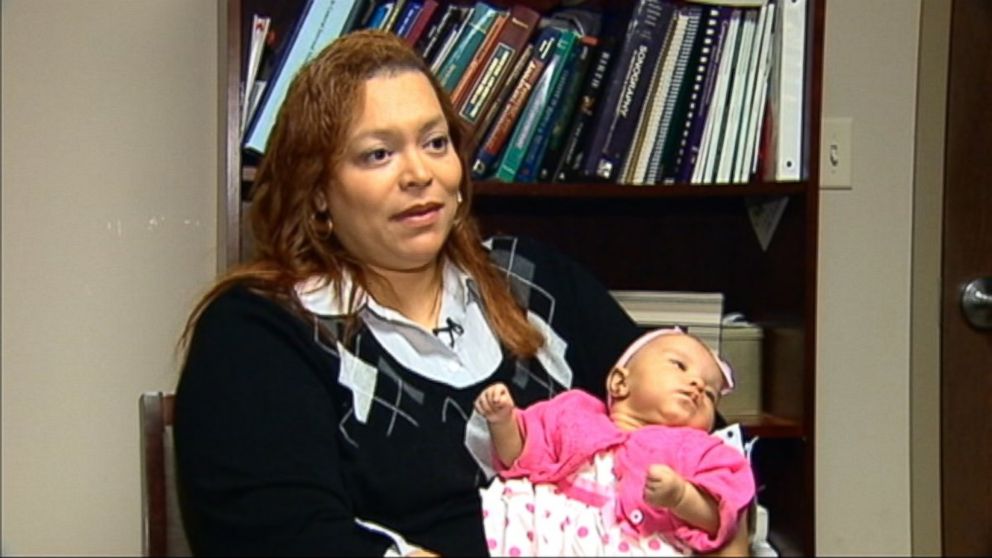Placenta Gives Life, But Can Also Kill as C-Section Rate Climbs
Risk of placenta accreta rises in women with multiple C-sections.

March 14, 2014— -- Barbara George said she would never have had five children by cesarean section if she'd known it could have killed her. The South Orange, N.J., mother nearly hemorrhaged to death on the operating table in 2010 as a result of placenta accreta, a life-threatening condition that is on the rise.
Her daughter Hannah, now 3, survived, but doctors were forced to give George a hysterectomy.
The placenta is an incredible organ that for nine months sustains the life of an unborn child. But it can also be deadly, fueled by the staggering cesarean rate in the United States -- 32.8 percent of births, according to the U.S. Centers for Disease Control and Prevention.
Sometimes, for no explainable reason, the placenta grows abnormally and invades the uterine wall. Women who have had previous cesarean sections are at greatest risk for the condition and the risk rises each time she undergoes another.
"I know people who know what I went through and [still] they have gone and had cesareans unnecessarily," George told ABCNews.com. "Some of them have pretty much a wink, wink, 'Schedule me a C-section' attitude."
Maternal deaths are on the rise in the United States.
In the 1970s, placenta accreta was a rare event, affecting 1 in 4,000 pregnant women. But now it strikes 1 in 533 pregnancies, according to latest statistics from the American College of Obstetricians and Gynecologists (ACOG).
Those rates get even higher with each subsequent cesarean and are compounded when a woman also has placenta previa, when the placenta sits too close to the cervix.
Normally, the Nitabach layer prevents the placenta from invading the uterine wall. But a Caesarian, or any kind of surgery, including an abortion or a D&C (dilation and curettage), can destroy that layer allowing the placenta to invade the body cavity.
"I am shocked, saddened, disheartened and angry," said George, now 40. "But I am not surprised."
Neither is Dr. Chavi Karkowsky, a maternal-fetal expert at Montefiore Medical Center in New York City. Karkowsky writes about the dangers of placenta accreta in a March 12 article in the Atlantic Monthly, "When a Placenta Tries to Kill a Mother."
"The numbers are shocking," Karkowsky told ABCNews.com. "It's something women should know about."
At Montefiore, the cesarean rate is about equal to the national average at 32.7 percent.
"Placentas are, for the most part, simply amazing," she writes. "They're one of the first parts of the pregnancy to form -- a whole organ that humans make simply for the purpose of nourishing a new human. The placenta lands in the uterus, and grows downward and outward. Complicated structural and immune changes of pregnancy allow the woman's body to tolerate what, in other circumstances, we would probably perceive as a parasitic invasion."
"Sometimes, however, the placenta doesn't get the signal to stop growing. It keeps spreading, down and out, through the lining of the uterus ... or the placenta can keep growing through to the muscle wall of the uterus. ... And, horrifyingly, it can penetrate through the uterus, working its way to adjacent organs such as the bladder or bowel."
A woman who has had one prior cesarean has a risk of 3 percent; a second cesarean ups the risk to 11 percent; at the third, 40 percent; fourth, 60 percent; and by the fifth, the risk of placenta accreta jumps to 67 percent, according to ACOG.
The maternal mortality with placenta accreta has been reported to be as high as 7 percent, according to ACOG.
"As a discipline, obstetrics is struggling with the C-section rate now and you see it in the literature," said Karkowsky. "ACOG is really trying to help us see why it is so high and how many are avoidable."




